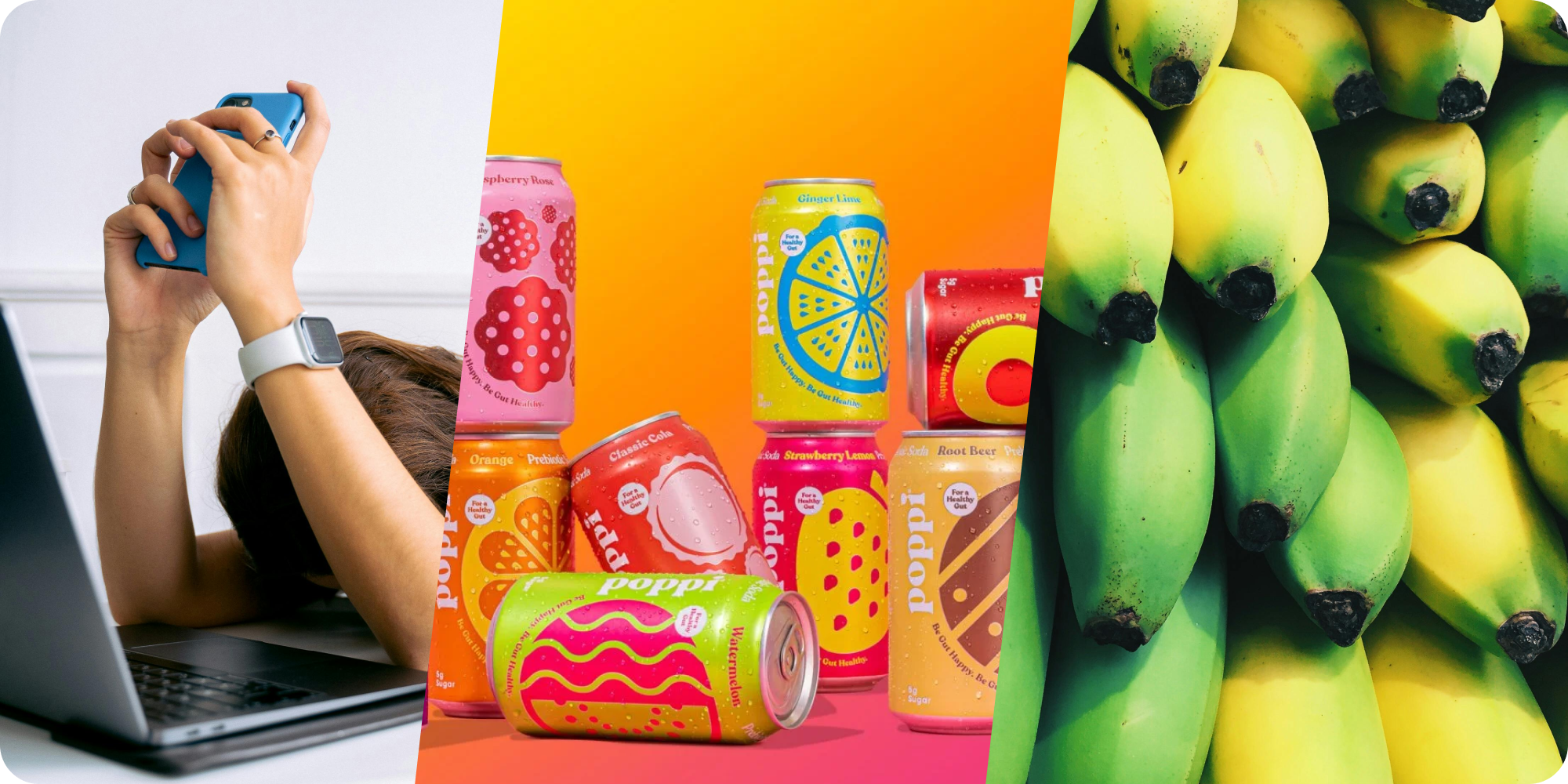June Workplace Insights: Reclaiming Focus, Function, and Flow
How office traffic, decision fatigue, and functional foods are reshaping the workplace.
✍️ Written by Rebecca Ross
🕚 6-Minute Read • Published Friday, May 30, 2025
![Trends for your corporate food service [June 2025] Trends for your corporate food service [June 2025]](https://info.craftydelivers.com/hubfs/Trends%20for%20your%20corporate%20food%20service%20%5BJune%202025%5D.png)
June is bringing fresh momentum into the office. With midweek traffic on the rise and wellness still top-of-mind, teams are paying closer attention to the moments that shape the workday. Your pantry is in a prime position to reflect your company’s values, support team performance, and drive the in-office experience.
This month, we’re tracking how foot traffic is shifting service strategies, how decision fatigue is draining productivity, and why collagen is becoming a quiet powerhouse in functional snacks. If you’re planning for people, not just policies—this one’s for you.
Office Traffic Is Climbing
Placer.ai’s latest office index offers fresh insight into return-to-office patterns.

Office activity continues to trend upward, with Placer.ai’s April Office Index reporting the third-highest visit volume since the start of the pandemic. Major metros like San Francisco, New York City, and Chicago are leading the rebound, while smaller but fast-growing hubs like Raleigh and Austin are gaining ground.
What’s especially noteworthy is how predictable these patterns have become. While the broader return-to-office landscape remains hybrid, there’s now a clear cadence to when employees are showing up, and it’s giving workplace teams a more actionable window to work with.
Key insights from Placer.ai’s April data:
- NYC office visits were as close as they have ever been to April 2019 levels
- Tuesday traffic in NYC was up +3.7% compared to April 2019
- Midweek visits (Tues/Wed) outpaced 2019 levels in several markets
- San Francisco and Chicago continue a steady month-over-month recovery
- Hybrid is holding firm as the dominant model, but it’s more predictable now
Understanding these rhythms is key to delivering workplace programs that land. When you know who is coming in and when, you can tailor everything from staffing to pantry stocking to maximize those high-value moments.
The tea: As office rhythms shift, the pantry has become a lever to bring people in. Food and drinks are valuable currency when budgets are tight, time is limited, and every commute has to feel worth it. Bringing them in-house protects focus, sparks collaboration, and fuels innovation.
When teams know their time in the office will be supported, energized, and valued, they’re more likely to show up. It’s also a quiet but powerful part of your compensation package, providing daily financial relief to employees.
A pantry program serves as a high-impact touchpoint:
- Encouraging team presence during critical collaboration days
- Supporting focus and productivity by minimizing off-site disruptions
- Reinforcing company culture through curated, values-aligned choices
- Delivering tangible value in moments that matter
The difference between a perk and a strategic asset is intention, and data is the unlock. Centralized systems and processes help you understand when people show up, what they reach for, and how to match service to that behavior.
That not only delivers a better pantry, but it's better business. With the right visibility and controls, you can be flexible in what you offer, precise in how you plan, and efficient in how you spend. It’s about making every dollar work harder for your people and your bottom line.
2025 WORKPLACE TRENDS REPORT
7 PREDICTIONS TO FUTURE-PROOF YOUR WORKPLACE
Discover seven research-backed predictions and actionable strategies to transform your workplace into a connection catalyst that drives meaningful results.
Decision Fatigue Is Costing You
Forbes highlights it as an invisible energy drain and how to design around it.

Small choices stack up fast. According to psychologist Dr. Jessica Myszak in a recent Forbes interview, decision fatigue is one of the most overlooked threats to mental energy in the workplace. From “How should I prioritize my day?” to “What meetings can I skip?” or “What should I eat?”, the sheer volume of micro-decisions teams face daily adds up, especially in high-demand, knowledge-driven roles.
This isn’t only about indecision, it’s about depletion. Even minor choices require mental effort, and over a day, that effort quietly chips away at focus, willpower, and critical thinking. As the article puts it: "It’s the invisible friction that slows you down without you realizing it.”
For leaders focused on performance, the implication is clear: the fewer low-stakes decisions your teams have to make, the more bandwidth they retain for work that matters.
The tea: The pantry is a powerful tool for reducing cognitive load, but only if it’s thoughtfully designed. When energizing, well-merchandised options are easy to see and grab, teams aren’t stuck scanning shelves or wondering what fits their dietary needs. They just refuel and move forward to decisions.
Done well, pantry design becomes a quiet enabler of sharper thinking. It removes noise from the workday, supports smoother routines, and signals that the workplace is working with employees, not against them.
Here’s what that looks like in practice:
- Curated snack assortments based on actual consumption data, not guesswork
- Smart product placement that surfaces top picks and diet-friendly options
- Consistent presentation and restocking, so people don’t have to “figure it out” daily
- A clear snack organization that reduces hesitation and promotes better decisions
Small as it seems, these moments matter. Because when people spend less time choosing, they spend more time thinking. And that shift, multiplied across teams, is where the impact adds up.
Collagen Is Quietly Taking Over Functional Foods
A wellness-driven ingredient is going mainstream and reshaping snack expectations.

Once considered niche, collagen has quickly moved into the spotlight, fueled by consumer interest in beauty, joint health, recovery, and overall well-being. According to Food Dive, Darling Ingredients is expanding its investment in collagen production to meet rising demand, while launching a joint venture, Nextida, focused entirely on collagen-based health products. What used to be a supplement aisle staple is now showing up in everything from sparkling waters and snack bars to on-the-go oatmeal cups.
The shift reflects a broader trend: employees want more from their food. They’re not just snacking to satisfy hunger, but they’re snacking for energy, for focus, for wellness. Functional snacks offer a way to support well-being while staying aligned with your culture and values.
The tea: Functional doesn’t have to mean fringe. A valuable pantry doesn't mean you constantly have to bring in new categories; you simply have to make thoughtful upgrades to familiar favorites. Think: a protein-boosted chip, a drink that supports gut health, or a snack bar with brain-boosting ingredients. Take Purely Elizabeth’s Vanilla Pecan Superfood Oat Cup with Collagen. It’s still the oatmeal people already love, but with a little something extra.
This is about meeting employees where they already are in their wellness journeys. And when done right, these choices:
- Signal care and intention through products that support both health and taste
- Boost the value of the pantry without adding operational complexity
- Increase engagement by offering something employees actively seek out
- Support inclusivity with options that speak to a range of dietary and wellness goals
Workplace food is no longer just about what’s easy to stock. It’s about what resonates. And with more people using food as a tool for self-care and performance, incorporating functional options like collagen isn’t a luxury—it’s an expectation from a modern workplace.
Conclusion
If May was about settling into new routines, June is about leveraging them. Office traffic is gaining definition. Employee expectations around food, wellness, and focus are sharper than ever. And the companies getting it right are the ones aligning their workplace programs to these behavioral signals, not assumptions.
Whether it's rethinking how and when you stock, curating for cognitive ease, or adding quiet wellness wins like collagen, every detail counts more than ever. Because when you plan for how people really work, you get a workplace that works


